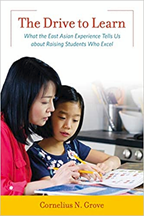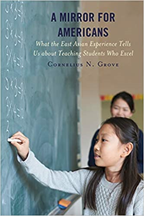


Since 1970, students from East Asia have outscored their U.S. counterparts on every international student comparative test. Every test over 50 years; no exceptions. “Why is this always true?” asked Dr. Cornelius Grove. Now he has answers.
“I approached this as an interculturalist and an educator. I wanted to uncover the historical and cultural factors behind East Asian students’ repeated successes,” Dr. Grove explains.
Immersing himself in hundreds of research reports concerning East Asian children’s learning advantages, Dr. Grove resurfaced with two principal reasons for their academic prowess. The first is that they are raised at home in such a way that they arrive at school with a drive to learn academically. The second is that during their most impressionable years (preschool–grade 5), they are taught by means of lessons that are knowledge-centered, not teacher-centered.
Dr. Grove’s 138-page book for parents, The Drive to Learn: What the East Asian Experience Tells Us about Raising Students Who Excel, explores the ways East Asian parents instill in their children a receptiveness to the formal learning process. After seven chapters explaining the values underlying the parents’ mindset, he offers three chapters revealing their supportive practices. It’s an outline for action for American parents who deeply value academic learning.
A Mirror for Americans: What the East Asian Experience Tells Us about Teaching Students Who Excel is the 148-page companion volume in which Dr. Grove examines the school side of the learning equation. East Asian lower-grade lessons gain the advantage because of their focused and tenacious attention to the day’s topic. Among other things, he addresses how East Asians regard teaching, learning, and why their math teaching has been so effective. Choice magazine (June issue) “highly recommends” this book for “general readers through faculty.”
Although each book effortlessly stands alone, The Drive to Learn and A Mirror for Americans combine to encourage complementary reassessments by parents and lower-grade teachers about the more impactful roles they could be playing in upgrading the academic performance and eventual college readiness of our youngest Americans.
For more detailed overviews, visit TheDriveToLearn.info and AMirrorForAmericans.info.
Author Cornelius N. Grove holds a Master of Arts in Teaching degree from Johns Hopkins and a Doctor of Education from Columbia. He has had a decades-long fascination with the cultural factors that affect children’s ability to learn in school. At a 2005 conference in Singapore, he spoke about the two instructional styles found around the world. In 2013 he wrote The Aptitude Myth: How an Ancient Belief Came to Undermine Children's Learning Today, a historical study of why most Americans believe that inborn ability determines school performance. For two recently published encyclopedias (2015 and 2017), he wrote entries on “pedagogy across cultures.” And now with A Mirror for Americans and The Drive to Learn, he is revealing the complementary roles home and school play in strengthening children’s academic performance.
He also blogs about writing nonfiction at corneliusgrove.medium.com.
The Drive to Learn: What the East Asian Experience Tells Us about Raising Students Who Excel
Publisher: Rowman & Littlefield (Lanham, Maryland)
Hardback: 978-1-4758-1509-2
Paperback: 978-1-4758-1510-8
eBook: 978-1-4758-1511-5
Available from Rowman.com, Barnesandnoble.com, Amazon.com and other booksellers.
A Mirror for Americans: What the East Asian Experience Tells Us about Teaching Students Who Excel
Publisher: Rowman & Littlefield (Lanham, Maryland)
Hardback: ISBN 978-1-4758-4460-3
Paperback: ISBN 978-1-4758-4461-0
eBook: ISBN 978-1-4758-4462-7
Available from Rowman.com, Barnesandnoble.com, Amazon.com and other booksellers.










